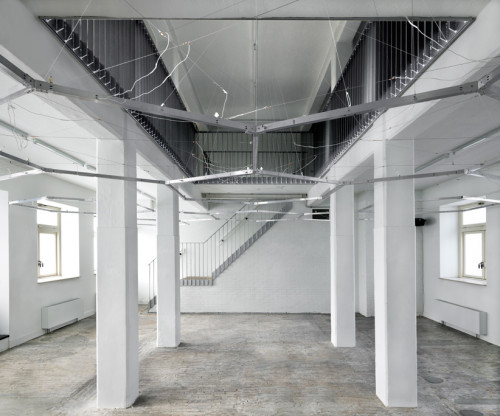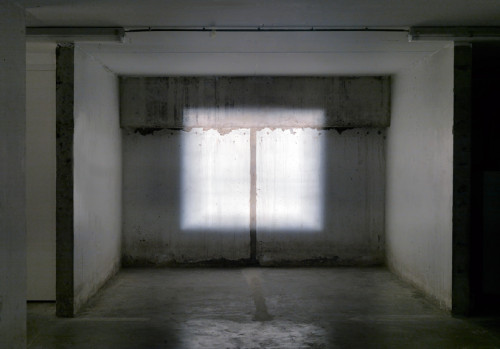
Kerstin Ergenzinger, Navigating Noise, 2015. Photo: Gert Jan van Rooij.
Acts of Orientation
KERSTIN ERGENZINGER
June 4 – July 17, 2016
In response to a rapidly changing world, Kerstin Ergenzinger puts to the test the knowledge we have of our surroundings and our perceived place within our environment. Her immersive installations constitute hybrid beings between machine and creature. They function like sense organs; scanning the space, and registering changes which are sometimes as subtle as a breath of air, or following and responding to our bodily movements.
NAVIGATING NOISE
The central point of the exhibition Acts of Orientation is Ergenzinger’s sound installation Navigating Noise: a poetic exploration of how to orient oneself in space through sound and movement. The installation is an interactive, sonic architecture environment through which one can move freely, navigating its sounds and noises. Upon entry into the bathhouse the visitor steps into a world of sounds brought forth by a beehive-shaped aluminium structure which is suspended in space. Ergenzinger has woven approximately 100 meters of piano wire through the structure, which is bound together with Nitinol-wire. This ultra-thin robotic muscle wire is set into motion by the pulse of modulated communication frequencies coming from the controlling program. As a result, the installation is brought to life by the vibrating piano wire and the resonating aluminium body, creating an endless range of sound qualities that are reminiscent of everyday noises that shift between natural and man-made phenomena. While moving through the space the soundscapes constantly shift their tone of voice, translating the viewer’s whereabouts into changing acoustic fields by means of a complex feedback system. Navigating Noise is a metaphorical space, linking a physical experience with the abstract notion of a world increasingly determined by data flows and electronic pathways. The installation renegotiates questions about the relationship between body, sound, and space and between the natural and technological conditions of our time. How do we distinguish information in what appears to be noise? How do we orientate ourselves within diffuse surroundings?
LIGHT AND HAND DRAWINGS
The installation Raumtaster transforms the dark, dusty basement of the bathhouse into an immersive light drawing. Ergenzinger has modified an overhead projector into a programmable drawing machine. The machine creates a choreography of luminous lines and fields that wander across the walls, ceiling and floor, scanning and demarcating the space. Raumtaster functions as a sense organ, employing light as a means of touch. The wandering light highlights everything it finds on its path, making no distinction between floor or ceiling, body or wall, while drawing attention to the characteristics of the space. Small details become important elements within the image. Bare walls function both as projection screens as well as the projected image. While scanning the surface and limits of its surroundings, Raumtaster generates new vistas and horizons within the confinements of the basement. In the smallest room of the bathhouse Ergenzinger returns to her own sense of touch: her hands. With a series of intimate drawings, she has set herself to the almost impossible task of meticulously following the lines of the palms of her hands. Throughout this process of orientation between her body and the perception of her body she often loses her way.
ACTS OF ORIENTATION
Central themes within Ergenzinger’s artistic investigations are the inextricable relation between body and the world, between perception and the perceived, between sensing and sense making. Seeing, listening, touching and smelling are not only physiological facts, but can also be considered as acts of engaging with the world. Because it is in the engagement with the world, that the world—and oneself within that world—is constituted.
According to the philosopher Maurice Merleau-Ponty meaning comes to being as our bodies enter into a relationship with the world. Our sense-making of the world always takes place within the world of our lived-bodies. Our senses are the dimensions by which we come to realize and interrogate ourselves as being-in-the-world. Not only does perception unfold within the world we perceive, it is foremost a fundamental condition of our existence: an existence that is perceptually sensed and made sense of. Sensing discovers and generates the sensed. In other words, one draws their sense of the world, to which one gives a sense by perceiving it. The sensible is directly connected to intelligibility. For Merleau-Ponty, inhabiting space entails creating the meaning of space. Furthermore, to move in the space is also to move at the same time within the self. The thought is the movement, which changes with the situation. However, the situation also changes with the movement. Such is also the nature of the relation between the space and the subject. Seeing, listening, touching, smelling, as well as moving are acts of orientation, enabling us to understand and (re)establish our subjective position within our world. Additionally, it is through these acts that meaning is constituted and that we are—figuratively speaking—able to know.
ONGOING INVESTIGATIONS
The development of Navigating Noise and the exhibition at A Tale of A Tub are part of the ongoing interdisciplinary research project Acts of Orientation by artist Kerstin Ergenzinger, physicist Thomas Laepple, and curator Nathanja van Dijk. In collaboration with the research group »Analog Storage Media« of the Cluster of Excellence Image Knowledge Gestaltung at Humboldt-Universität zu Berlin and the Schering Stiftung (Berlin) they investigate forms of orientation in our ‘technologised’ world from a spatial-physical, as well as natural science and humanities perspective.

Kerstin Ergenzinger, Navigating Noise, 2015. Photo: Gert Jan van Rooij.

Kerstin Ergenzinger, Raumtaster, 2013. Photo: Gert Jan van Rooij.